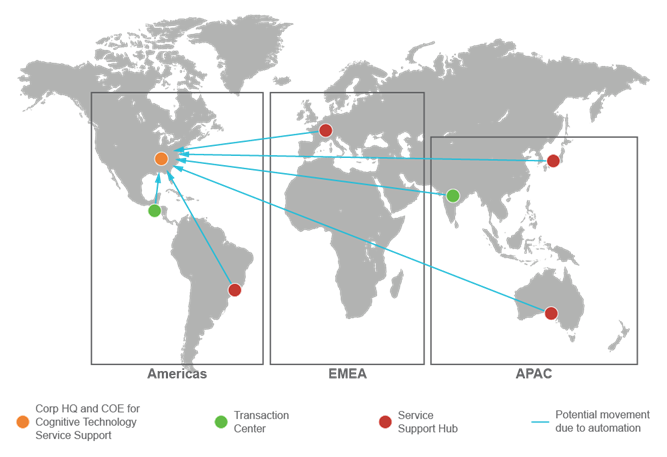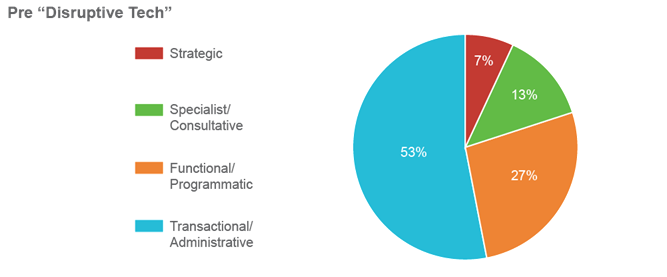
This is the third article in a series of three focused on intelligent automation in today’s global business services.
Article 1: Global Business Services: The Evolving Standard for Global Service Delivery
Article 2: Intelligent Automation on the Horizon
As described in prior articles, “Global Business Services: The Evolving Standard for Global Service Delivery” and “Intelligent Automation on the Horizon,” three intelligent automation technologies are quickly being adapted to shared services solutions: Robotic Process Automation (RPA), Virtual Agents (VA), and Artificial Intelligence (AI). What appeared to be a gradual testing of the waters a few years ago has turned into a tidal wave of new solutions that are yielding surprising results. These technologies are no longer “on the horizon,” they are “here.” The questions we face are: (1) what is their potential impact on global business services (GBS), and (2) what should GBS executives be doing to prepare for them?
If you want to better understand the potential impact of the new intelligent automation technologies on GBS, just revisit all the decisions you made, or are thinking of making, to reduce labor costs. Let’s take a look at a few of these:
If all of these disruptive impacts are taken into consideration, the GBS global footprint we presented earlier might look like the figure below in the near future. Services currently located in foreign transaction centers and regional service hubs might be moved back to the company’s headquarters or located wherever RPA, VA, and AI talent is available.

Based upon the results achieved to date, plus the potential range of future applications, we believe the cost-saving implications of intelligent automation technologies are impressive. In fact, we estimate that RPA solutions are capable of automating as much as 70% of the transactional/administrative work typically performed by the GBS organization. Similarly, we anticipate that VA and AI solutions will eventually automate up to 65% of the functional/programmatic work and 35% of the specialist/consultative work performed by COEs and local support. The cumulative impacts of these reductions have the potential to reduce total GBS costs by nearly 50% when fully implemented.

The potential labor-savings impact of these technologies is staggering. On a company level, they have the ability to reduce costs, improve service, and cement your competitive position. On a global scale, it is estimated that they have the potential to replace more than 100 million knowledge workers or nearly one-third of the world’s knowledge-based jobs. These include jobs that require decision making, judgment, and human interaction and will impact everything from administrative clerks to middle management. No matter how we choose to adapt to this new world order, the introduction of these technologies is likely to be one of the 21st century’s primary social challenges. Some of the questions we face include:
Preparing to harness the impact of any disruptive technology is always problematic. Move too soon and you are on the “bleeding edge” of technology. Move too late and you may lose your competitive advantage. The one thing you cannot do is ignore it. The table below summarizes our view of where each of the three technologies is likely to impact GBS operations and what the potential impact is.

Below are some steps you might consider in moving forward. They are based on our experience in guiding companies through the adoption of intelligent automation technologies into their GBS organization.
1. Assess for Opportunities
If you have not already done so, designate a digital leader or team to assess intelligent automation technologies and understand their potential impact on your businesses.
2. Build the Case
Document the potential benefit of applying intelligent automation technologies and obtain management support for moving forward.
3. Prepare your data
All of the intelligent automation solutions are reliant on clean and well-structured data. Absence of this can lead to more problems than fixes. Questions around the ownership and use of data can also impede the process.
4. Select the Vendor and Pilot
Test the waters. Select a pilot GBS business process where favorable results are likely to be more readily achieved. Use the pilot to build support and better understand the degree of disruption inherent in these new technologies.
5. Implement Solution
If you selected your pilot business process appropriately, this should take three to nine weeks.
6. Manage Intelligent Automation Lifecycle
Move from the “project” environment to an ongoing “operations” environment. Make sure it sticks.
Regardless of your perspective, you can’t ignore that these new technologies are going to fundamentally affect how GBS organizations deliver their services in the future. Whether they represent a problem or an opportunity, it is better to face them now rather than postpone the inevitable. By effectively assessing your opportunities, building the case, and piloting the technologies, you will increase the likelihood of implementing an effective solution to improve your GBS operation for the future.
For more information on how ScottMadden can assist you in designing, implementing, or improving your GBS organization, please contact us.
View MoreSussex Economic Advisors is now part of ScottMadden. We invite you to learn more about our expanded firm. Please use the Contact Us form to request additional information.